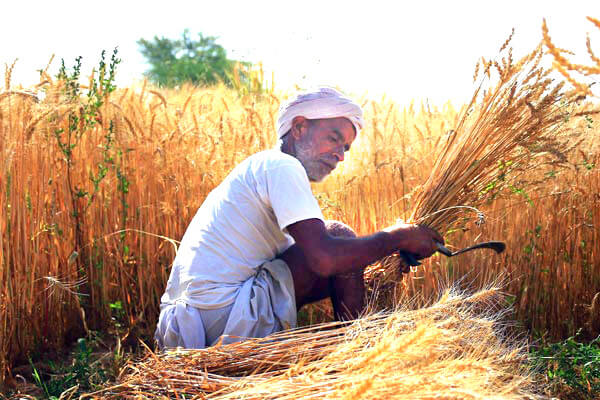
With Agriculture, Dairy and Animal Husbandry being the most prominent sectors in the state of Haryana, the state government has taken various initiatives to strengthen the industry. The recurring efforts by the authorities have gained laurels to the state’s agriculture practices and industry operations. Here are some of the achievements marked by the Haryana’s Agriculture and Farmers’ Welfare Department, writes Adarsh Som of Elets News Network (ENN).
Financial Aids and Benefits to Farmers
Haryana’s focus has been more towards farmers’ convenience and aiding them in adverse situations. Therefore, in order to meet the farmers’ risk, the government introduced the Pradhan Mantri Fasal Bima Yojana (PMFBY) in the state as the new insurance scheme in the Kharif season of 2016. Under the PMFBY, millet, paddy, cotton, maize, wheat, gram, barley, mustard and sunflower crops are being covered. Till Kharif 2019, 50.21 lakh farmers had been registered under this scheme and 11.49 lakh farmers have been given Rs 2632.06 crore as the insurance claim. During this period, a total premium of Rs 2524.97 crore was paid to the insurance companies, out of which the farmers’ share was only Rs 812.30 crore. The State Government paid Rs 996.01 crore and the Centre paid Rs 716.65 crore as premium. Moreover, the Haryana government disbursed Rs 2764.93 crore as compensation amount to the farmers under disaster management during 2014-15 to 2019-20.

Further, the state introduced the Pradhan Mantri Kisan Samman Nidhi Yojana (PM-KISAN) scheme to strengthen the farmers financially during the year 2019. Under the PMKISAN, every year an amount of Rs 6000 is being deposited in the bank account of the farmers through direct benefit transfers (DBT). As many as 16.53 lakh farmers have received the benefits of the scheme which accounts to Rs 1392.20 crore.
The Centre and the state governments have been proactively taking initiatives to double the income of farmers, especially after the onset of the COVID pandemic. To achieve this, the Centre increased the Minimum Support Price (MSP), one and a half times the cost, during 2014-15 to 2019-20. And, Haryana has been providing the highest state suggested price of sugarcane across India since the 2014-15. The Centre has declared the Minimum Support Price (MSP) of Kharif crops for the current year as Rs 1868 to1888 per quintal for paddy, Rs 2150 per quintal for millet, Rs 1850 per quintal for maize, and Rs 5515-5825 per quintal for cotton.

Moreover, in an effort to provide the farmers with better remuneration for their produce, the state implemented Price Support Scheme (PSS) from the year 2015-16 for the purchase of oilseeds and pulses such as sunflower, mustard, moong and gram. From the year 2017-18, Haryana has procured more oilseeds and pulses than what was approved by the Government of India.
Also Read: Can Augmenting Agriculture Revive Economy?
Promoting Sustainable Agriculture
Haryana has been active in promoting crop diversification in the state as the groundwater levels have been dwindling for the past decade. Considering the fact, the state launched a new scheme “Mera Pani Meri Virasat”. Under the scheme, farmers are being provided with the financial assistance of Rs 7000 per acre by the government to the farmers for replacing more water-consuming crops with other crops like Maize, Cotton, Millet, Vegetables and Pulses. In addition, the crops will also be insured by the government. As per the scheme, for the adoption of micro-irrigation, 40 percent subsidy will be given to the farmers on the Maize Planter and Ridge Bed Planter and only the GST will be charged on the farmers in eight selected blocks. Further, a Maize Dryer will also be provided in the mandis to control the moisture content in the harvest.
Moreover, as another effective measure to reduce the use of groundwater for irrigation, it has been decided that paddy will not be sown on the land of the gram panchayats of the 12 blocks where the groundwater level is more than 35 meters. As per the government data, under the scheme, 53,024 farmers have registered on Mera Pani Meri Virasat Portal for the cultivation of alternative crops replacing paddy. Additionally, financial assistance of Rs 7500 per acre will also be provided to the concerned gram panchayat.
Also, Haryana introduced ‘Atal Ground Water Scheme’ in the year 2019 wherein 36 blocks of 13 districts have been selected for improving groundwater level. To implement the scheme, a provision of Rs 723.19 crore has been provided for the next five years.
Haryana’s approach towards establishing sustainable agriculture practices also include the promotion of organic and natural farming. The state’s Agriculture Department claims that organic and natural farming practices will be expanded to an area of one lakh acres in the coming three years. Further, for the adoption of micro-irrigation method, the Haryana government is providing 85 percent of the total cost of grant to all categories of farmers and the provisions began in the previous year, 2019 onwards.
Support for Agri-Tech and Agri-Equipment
Haryana’s agriculture department has been introducing better machinery and effective tools and equipment to support the farmers for efficient farming. The department is providing agricultural equipment such as direct paddy sowing machine, laser land leveller and maize sowing machine at free and minimum rates. The farmers are being informed of the provisions through demonstration plants.
Combating COVID Crisis
The Haryana government was proactive in setting up safety nets as the COVID pandemic hit the state. Extensive arrangements were made to protect all the mandis across the state from the coronavirus and hand sanitizers were provided to the farmers, labourers and traders in all the mandis. Further, wearing of masks and thermal scanning before entering and exiting the mandi were made mandatory.
In order to abide with the physical distancing norms, in 28 mandis, the government/agricultural board opened 1835 procurement centres for wheat and 165 procurement centres for the purchase of mustard and gram.
Also Read: Strengthening Agriculture & Rural, Curbing Economic Crisis : Explains P S Pradyumna
In order to aid the farmers affected by the pandemic, the Haryana State Agricultural Marketing Board increased the cover limit to Rs 10 lakh on death due to COVID-19 under the Chief Minister Farmer and Agricultural Laborers’ Life Protection Scheme. Moreover, the Board revised labour rates for the mandi labourers working during the pandemic.
Achievements Unlocked
Haryana was awarded the Best Horticulture State Award in 2016 for overall achievements in the field of horticulture. Under the mission, 97,199 farmers were provided with subsidies in the last five years. Moreover, an amount of Rs 46,065 crore has been given to 46,065 beneficiaries through DBT, which is the highest among all states in India, in the past two years.
To further enhance the horticulture and promote other farming categories like beekeeping, Haryana is providing 40 percent grants for mushroom cultivation and 185 units have been approved, as per the government data. Also for promoting beekeeping, 85 percent assistance has been made for procurement of bee boxes and 75 percent assistance on purchase of bee equipment, honey processing, bottling and honey testing. The state has set up 38 Centres of Excellence to showcase the latest horticultural techniques and two new centres are underway.
Haryana became the first state in the country to start the Bhavantar Bharpai Yojana (BBY) in January 2018. As of yet, 50,000 farmers have been registered and about 4000 farmers of the total registered have been given compensations worth Rs 10.88 crore.
Under the Post-Harvest Management (CBD), the government is providing 35 percent assistance on cold storage and its capacity has been increased from 0.80 lakh MT to 2.30 lakh MT in the last five years.
Furthermore, under the skill India mission, traininigs have been provided to the farmers and youth for effective and sustainable agriculture practices and techniques. Certificates have been issued to 17,275 farmers and youth.
Hybrid vegetable seedlings (134 lakhs) of capsicum, cucumber, tomato, musk and brinjal were produced under high-tech greenhouses and distributed to farmers at 50 per cent assistance. 1.05 lakhs of finished fruit plants were distributed to the farmers.
Be a part of Elets Collaborative Initiatives. Join Us for Upcoming Events and explore business opportunities. Like us on Facebook , connect with us on LinkedIn and follow us on Twitter, Instagram.











